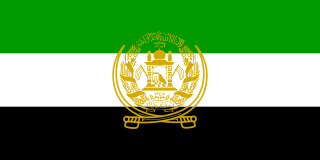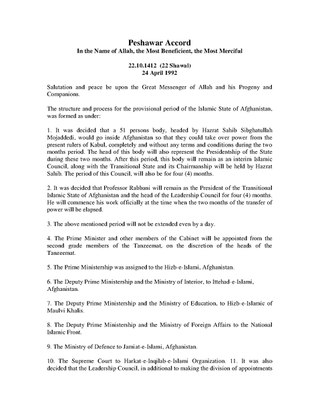
Ahmad Shah Massoud was an Afghan politician and military commander. He was a powerful guerrilla commander during the resistance against the Soviet occupation between 1979 and 1989. In the 1990s, he led the government's military wing against rival militias; after the Taliban takeover, he was the leading opposition commander against their regime until his assassination in 2001.

Gulbuddin Hekmatyar is an Afghan politician, former mujahideen leader and drug trafficker. He is the founder and current leader of the Hezb-e-Islami Gulbuddin political party, so called after Mohammad Yunus Khalis split from Hezbi Islami in 1979 to found Hezb-i Islami Khalis. He has twice served as Prime Minister during the 1990s.

This article on the history of Afghanistan covers the period from the fall of the Najibullah government in 1992 to the end of the international military presence in Afghanistan.

The Islamic State of Afghanistan was established by the Peshawar Accords of 26 April 1992. Many Afghan mujahideen parties participated in its creation, after the fall of the socialist government. Its power was limited due to the country's second civil war, which was won by the Taliban, who took control of Kabul in 1996. The Islamic state then transitioned to a government in exile and led the anti-Taliban Northern Alliance. It remained the internationally recognized government of Afghanistan at the United Nations until 2001, when the Transitional Islamic State of Afghanistan was created and an Afghan Interim Administration took control of Afghanistan with US and NATO assistance following the overthrow of the first Taliban government. The Transitional Islamic State was subsequently transformed into the Islamic Republic, which existed until the Taliban seized power again in 2021 following a prolonged insurgency.

Abdul Rasul Sayyaf is an exiled Afghan politician and former mujahideen commander. He took part in the war against the Marxist–Leninist People's Democratic Party of Afghanistan (PDPA) government in the 1980s, leading the Afghan mujahideen faction Ittehad-al-Islami.

The Islamic Dawah Organization of Afghanistan is a political party in Afghanistan led by Abdul Rasul Sayyaf. Founded in the early 1980s as the Islamic Union for the Liberation of Afghanistan, it was originally an attempt to bring unity amongst Islamist opposition forces in Afghanistan. However, the creation of the new umbrella organization effectively created a split and the organization became a political party of its own. The organization was part of the 'Peshawar Seven', the coalition of mujahedin forces supported by the United States, Pakistan and various Arab states of the Persian Gulf in the war against the PDPA government, Soviet forces and Ba'athist Iraq. Through the financial aid received from Saudi sources, the organization was able to attract a considerable military following. Arab volunteers fought in the militia forces of the organisation.

Jamayat-E-Islami, sometimes shortened to Jamiat, is a predominantly Tajik political party and former paramilitary organisation in Afghanistan. It was originally formed as a student political society at Kabul University. It has a communitarian ideology based on Islamic law. During the Soviet–Afghan War and the following Afghan Civil War against the communist government, Jamiat-e Islami was one of the most powerful of the Afghan mujahideen groups. Burhanuddin Rabbani led the party from 1968 to 2011, and served as President of the Islamic State of Afghanistan from 1992 to 2001, in exile from 1996.

Mohammad Yunus Khalis was a mujahideen commander in Afghanistan during the Soviet–Afghan War. His party was called Hezb-i-Islami, the same as Gulbuddin Hekmatyar's party. The two are commonly differentiated as Hezb-e Islami Khalis and Hezb-e-Islami Gulbuddin.

The Northern Alliance, officially known as the United Islamic National Front for the Salvation of Afghanistan, was a military alliance of groups that operated between early 1992 and 2001 following the dissolution of the Soviet Union. At that time, many non-Pashtun Northerners originally with the Republic of Afghanistan led by Mohammad Najibullah became disaffected with Pashtun Khalqist Afghan Army officers holding control over non-Pashtun militias in the North. Defectors such as Rashid Dostum and Abdul Momim allied with Ahmad Shah Massoud and Ali Mazari forming the Northern Alliance. The alliance's capture of Mazar-i-Sharif and more importantly the supplies kept there crippled the Afghan military and began the end of Najibullah's government. Following the collapse of Najibullah's government the Alliance would fall with a Second Civil War breaking out however following the Islamic Emirate of Afghanistan's (Taliban) takeover of Kabul, The United Front was reassembled.
The Islamic Revolution Movement is a traditionalist Islamist political party. It was once one of the biggest Afghan mujahideen factions fighting against Soviet forces during the Soviet–Afghan War. Mohammad Nabi Mohammadi was the leader of the group at the time.

Mohammad Nabi Mohammadi was an Afghan politician and mujahideen leader who was the founder and leader of the Harakat-i-Inqilab-i-Islami political party and paramilitary group. He served as President of Afghanistan under the mujahideen from January 1993 to 1996.

The Hezb-e-Islami Gulbuddin, also referred to as Hezb-e-Islami or Hezb-i-Islami Afghanistan (HIA), is an Afghan political party and paramilitary organization, originally founded in 1976 as Hezb-e-Islami and led by Gulbuddin Hekmatyar. In 1979, Mulavi Younas Khalis split with Hekmatyar and established his own group, which became known as Hezb-i Islami Khalis; the remaining part of Hezb-e Islami, still headed by Hekmatyar, became known as Hezb-e Islami Gulbuddin. Hezbi Islami seeks to emulate the Muslim Brotherhood and to replace the various tribal factions of Afghanistan with one unified Islamic state. This puts them at odds with the more tribe-oriented Taliban.

The 1989–1992 Afghan Civil War, also known as the FirstAfghan Civil War, took place between the Soviet withdrawal from Afghanistan and the end of the Soviet–Afghan War on 15 February 1989 until 27 April 1992, ending the day after the proclamation of the Peshawar Accords proclaiming a new interim Afghan government which was supposed to start serving on 28 April 1992.

The 1992–1996 Afghan Civil War, also known as the Second Afghan Civil War, took place between 28 April 1992—the date a new interim Afghan government was supposed to replace the Republic of Afghanistan of President Mohammad Najibullah—and the Taliban's conquest of Kabul establishing the Islamic Emirate of Afghanistan on 27 September 1996.
The Afshar Operation was a military operation in Afghanistan that took place on February 11–12, 1993 during the Afghan Civil War (1992-96). The operation was launched by Ahmad Shah Massoud and Burhanuddin Rabbani's Islamic State of Afghanistan government and the allied Abdul Rasul Sayyaf's Ittehad-i Islami paramilitary forces against Gulbuddin Hekmatyar's Hezbe Islami and Abdul Ali Mazari's Hezbe Wahdat militias in the densely populated, Qizilbash-majority, Afshar district in west Kabul. The Hazara-Hezbe Wahdat together with the Pashtun-Hezbe Islami of Hekmatyar had been shelling densely populated areas in northern Kabul from their positions in Afshar, killing thousands. To counter the shelling, government forces attacked Afshar in order to capture the positions of Wahdat and its leader Mazari, and to consolidate parts of the city controlled by the government.

The Battle of Kabul was a series of intermittent battles and sieges over the city of Kabul during the period of 1992–1996.

The Afghan Mujahideen (Pashto: افغان مجاهدين) were Islamist resistance militias that fought the Democratic Republic of Afghanistan and the Soviet Union during the Soviet–Afghan War and the subsequent First Afghan Civil War.

The Shura-e Nazar was created by Ahmad Shah Massoud in 1984 at the northern provinces of Takhar, Badakhshan, Balkh and Kunduz, during the Soviet-Afghan War. It comprised and united about 130 resistance commanders from 12 northern, eastern and central regions of Afghanistan.

On 24 April 1992, the Peshawar Accord was announced by several but not all Afghan mujahideen parties: Gulbuddin Hekmatyar, leader of Hezb-e Islami, had since March 1992 opposed these attempts at a coalition government.
The Battle of Jalalabad, also known as Operation Jalalabad or the Jalalabad War, occurred in the spring of 1989. It involved the Seven-Party Union based in Peshawar, also known as the Afghan Interim Government or the "Government in exile", supported by the Pakistani intelligence agency ISI, attacked Jalalabad. The ISI's Director Gul wanted to see a mujahideen government over Afghanistan, led by Hekmatyar.















